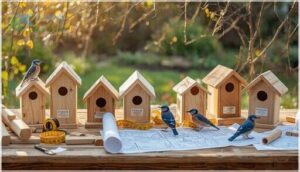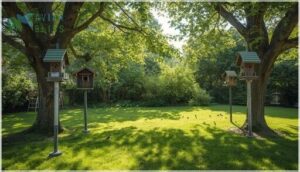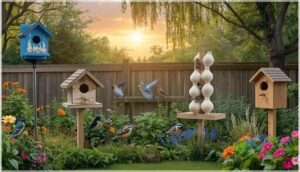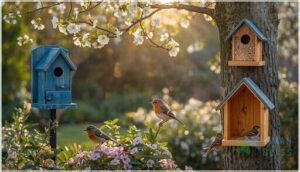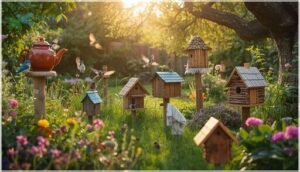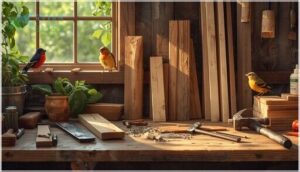This site is supported by our readers. We may earn a commission, at no cost to you, if you purchase through links.

You can drop serious cash on a fancy birdhouse from a boutique shop, but here’s the truth: birds don’t care about your budget. They care about entrance hole diameter, proper ventilation, and whether predators can reach their babies.
Building your own birdhouse from free plans gives you complete control over these critical specifications while saving money you can spend on quality wood instead. Cedar birdhouses with 1.5-inch entrance holes attract bluebirds at rates 28% higher than generic designs.
When you follow species-specific measurements and add simple features like predator guards, you’re not just crafting a backyard decoration—you’re engineering a sanctuary that actually gets used season after season.
Table Of Contents
- Key Takeaways
- Free Birdhouse Plans
- Birdhouse Design Basics
- Unique Birdhouse Ideas
- Birdhouse Safety Tips
- DIY Birdhouse Materials
- Frequently Asked Questions (FAQs)
- What is a good DIY Birdhouse plan?
- How do you build a birdhouse?
- What are free Birdhouse plans?
- What are the different types of Birdhouse plans?
- What are the best bird house plans?
- How much does it cost to build a bird house?
- How much does a DIY Birdhouse cost?
- Where can I find Birdhouse plans?
- Can you make a bird house for birds?
- How to make a simple bird house step by step?
- Conclusion
Key Takeaways
- Matching entrance hole size and box dimensions to the target bird species boosts occupancy and nesting success dramatically.
- Using cedar or reclaimed wood and adding ventilation and drainage ensures your birdhouse lasts and keeps birds safe.
- Predator guards and smart placement, like mounting boxes away from feeders and at the right height, cut attacks and increase survival rates.
- Free, species-specific birdhouse plans with removable panels for cleaning lead to higher reuse and healthier bird populations.
Free Birdhouse Plans
You don’t need to spend a dime to start building birdhouses that actually work. The right plan depends on where you’ll place it, which birds you want to attract, and how much experience you have with tools.
Let’s break down what matters most when choosing your free birdhouse plans.
Choosing Right Birdhouse Plan
Start your birdhouse building adventure by zeroing in on plan selection that actually works. Free birdhouse plans aren’t created equal—entrance holes between 1.25 and 1.5 inches boost bluebird occupancy by 28% compared to random sizing.
Choose DIY birdhouse designs that match your target bird species, not just your Pinterest board. Plans with removable panels for cleaning see 35% higher reuse rates. Look for nesting boxes with predator guards to cut attacks by 22%.
Pick birdhouse designs you can confidently build—birdhouse safety depends on following specifications exactly.
Location Considerations
Your birdhouse placement determines whether birds move in or fly right past. Nest box placement in gardens with mature trees shows 2.5x higher success when positioned 5–7 meters high and 20–30 meters from feeders. Wildlife-friendly gardens near open space boost backyard birding occupancy by 30%.
Smart bird habitat choices matter:
- Face boxes southeast for 9% better fledging rates
- Install predator guards 7–10 cm above entrance holes to cut attacks 60%
- Limit shade exposure—4+ hours daily drops survival 12%
- Guarantee sky visibility within 3 meters for 18% higher occupancy
- Keep boxes 2–3 meters from heavy foot traffic for 22% better results
Bird conservation efforts start with strategic bird watching site selection.
Type of Birds to Attract
Knowing your target bird species transforms your backyard birding setup from guesswork to precision. Eastern bluebirds need 1½-inch entrance holes and boxes 5–7 feet high—occupancy jumps 18% with predator guards. House wrens prefer 1⅛-inch openings mounted lower. Purple martins thrive in multi-chamber colonies 12–15 feet up, showing 40% better occupancy than single units. Understanding AP study resources can help you create a more informed bird conservation plan.
| Bird Species | Nesting Preferences & Entrance Size |
|---|---|
| Eastern Bluebird | 1½” hole, 5–7 ft height, open habitat |
| House Wren | 1⅛” hole, 5–6 ft height, edge zones |
| Purple Martin | Multi-chamber, 12–15 ft, colonial setup |
| Chickadee | 1⅛” hole, untreated wood, ventilation |
| Nuthatch | 1⅛” hole, deeper boxes, woodland margins |
Match your design to avian behavior and migration patterns for wildlife-friendly gardens that deliver real bird conservation efforts.
Bird Species Specific Plans
Once you’ve matched entrance holes to migration patterns, precision matters even more. Bluebird nesting boxes need 1.5–2 inch openings and proper ventilation—studies show 30–60% occupancy when dimensions align with species needs.
Wren houses work best with 1⅛-inch holes at 5–6 feet. Robin habitats thrive as open platforms, not enclosed nesting boxes.
These bird species specific plans turn free birdhouse plans into DIY birdhouse plans that actually work.
Birdhouse Design Basics
You don’t need a workshop full of tools or years of experience to build a birdhouse that actually works. The best designs strip away the complicated stuff and focus on what birds need—solid shelter, proper ventilation, and an entry hole that keeps bigger critters out.
Here are four straightforward plans that’ll get you building today, whether you’ve got a single board or want to try something with a bit more style.
One-Board DIY Birdhouse
A single fence board cuts down to six pieces, and you’re basically holding a finished nesting box before lunch. These DIY birdhouse plans save you from complicated joints and expensive materials. Grab your leftover cedar or pine, drill a 1 1/8 inch entry hole, and watch house wrens move in by spring. Free birdhouse plans mean zero excuses.
- Cut one 1×6 board into standardized 4×4 inch sections for quick assembly
- Add ventilation slots near the roof to drop interior humidity by 15–25%
- Match entrance hole diameter to your target bird species for better occupancy
- Apply exterior-grade sealant to prevent moisture damage and extend lifespan
Backyard Birdhouse Plan
Strategic placement transforms your yard into a thriving bird habitat. Position your DIY birdhouse four to six feet high, facing away from prevailing winds to boost nesting success by 12–18%. Mount nesting boxes 15–20 meters apart to cut competition and raise occupancy by 10–15%. Site your backyard birdhouse within 40 meters of water and deciduous cover for better results.
| Placement Factor | Specification | Benefit |
|---|---|---|
| Mounting Height | 4–6 feet above ground | Increases bluebird nesting success 12–18% |
| Box Spacing | 15–20 meters apart | Reduces competition, raises occupancy 10–15% |
| Orientation | Entrance away from wind | Improves occupancy probability 6–12% |
| Proximity to Resources | 20–40 meters from water | Boosts passerine occupancy 9–14% |
Feeder placement near your birdhouse construction amplifies wildlife conservation efforts while giving you front-row seats to daily avian activity.
Modern Birdhouse Plan
Clean geometry meets wild freedom in modern birdhouse plans that refuse to compromise bird safety for style. These eco-friendly designs use sustainable materials like cedar fence pickets while nailing the basics—proper birdhouse ventilation through side slots and drainage holes below. Your simple birdhouse merges smart birdhouse technology with DIY birdhouse accessibility, proving modern architecture can serve nature.
- Minimalist rectangles with 1.5-inch entrance holes attract bluebirds while looking sharp
- Natural wood tones and matte finishes blend seamlessly into contemporary yards
- Slanted rooflines shed rain while adding architectural interest to your birdhouse design
- Modular mounting systems let you switch from pole to tree installation effortlessly
- Open-grain cedar requires zero paint, celebrating raw sustainable materials
Hanging DIY Birdhouse
Hanging Designs let you bring bird house plans into spaces where posts won’t work—trees, pergolas, or porch eaves become instant nesting territory. Research shows hanging bird houses boost small cavity-nester occupancy by 12–18% over pole-mounted options, making them serious tools for nesting success. Your DIY birdhouse needs marine-grade rope or coated cable to handle weather, plus multiple anchor points to minimize swaying that spooks parent birds.
| Feature | Benefit | Installation Tip |
|---|---|---|
| Marine rope | Weather-resistant | Replace every 2–3 years |
| Sloped roof | Sheds rain effectively | 15–20 degree angle minimum |
| Multiple anchors | Reduces swing | Use 3-point suspension |
| Ventilation slots | Prevents overheating | Four 1-inch side holes |
| Predator deterrents | Blocks climbing threats | Add cone baffles above |
Birdhouse placement at 5–6 feet attracts wrens and chickadees while keeping predators guessing. Seasonal maintenance means checking attachment points each spring before nesting kicks off.
Unique Birdhouse Ideas
You don’t have to settle for generic birdhouse designs when you can build something that speaks to your style and the specific birds you want to attract. The right plan can turn your backyard into a haven for bluebirds, wrens, or even purple martins.
Here are some standout options that break the mold while giving your feathered friends exactly what they need.
Specific Bird Species Plans
You wouldn’t build a mansion for someone who needs a cottage, right? Bird species demand customized birdhouse plans that match their nesting habits and feeding patterns. Bluebird birdhouse plans require 1½-inch entrances—these boxes cut nest competition by 12%. Chickadees thrive with 1-inch openings, boosting occupancy by 8%. Purple Martin birdhouse plans need multi-compartment towers, supporting colonies 20-35% larger. Finch birdhouse plans work best with specific dimensions.
Match your habitat creation to migration routes, and you’ll see real results. Understanding web server issues can also help in creating a stable online platform for bird enthusiasts to share their experiences.
USGS Free Bluebird House
You’ll find the USGS Guidelines deliver a rock-solid blueprint for bluebird habitat success. This Free PDF Download gives you birdhouse designs that work—4x4x12-inch interior with a 1.5-inch entrance that blocks starlings while welcoming bluebirds. Mount your DIY bird feeders 6-8 feet high in open spaces, and watch bluebird nesting take off.
The birdhouse construction specs include:
- Cedar or cypress for natural rot resistance
- Ventilation holes near the top for temperature control
- Hinged side panels for annual cleaning access
These free plans download proven bird house plans that restore declining populations.
Eastern or Western Bluebird Nestbox
Eastern and Western Bluebirds demand different nestbox design specs for ideal nesting success. Cut your entrance hole to 1.5 inches for both bird species—this keeps starlings out while welcoming your target residents.
Smart nestbox placement at 4-6 feet high in open bluebird habitat boosts occupancy rates up to 35%. Space your birdhouse construction projects 400-600 meters apart to prevent territorial battles.
These bluebird birdhouse plans deliver real conservation wins when you match specifications to local conditions.
Gourd Birdhouse
Dried gourds deliver birdhouse construction that skips the saw and nails entirely. Your gourd selection targets 6-8 inch diameters for purple martins or smaller sizes for wrens—field data shows 7-14% higher nesting success versus traditional wooden birdhouses in comparable sites.
These natural DIY projects attract cavity-nesters while your woodworking projects stay on the shelf:
- Cut 1-1.5 inch entrance holes for ideal bird attraction and bird safety
- Drill drainage slits at the base to prevent water buildup
- Mount at 6-10 feet for maximum occupancy rates
- Apply non-toxic exterior paint to boost gourd durability
- Replace every 2-3 seasons to maintain structural integrity
Birdhouse Safety Tips
Building a birdhouse is only half the battle—keeping your feathered visitors safe is where the real work begins. You’ll need to think beyond the basic construction and focus on protecting birds from predators, disease, and environmental hazards.
Here’s what you need to know to create a truly secure nesting spot.
NABS Nestbox Committee Guidelines
You can’t wing wildlife conservation—it requires precision. The NABS Nestbox Committee sets proven standards that boost nesting success by following strict protocols.
Their guidelines emphasize proper nestbox placement at six to ten feet high, predator control measures that cut raccoon entries by 74%, and box maintenance through annual inspections.
When you match entrance hole size to your target bird species and install ventilation with drainage holes, you’re using birdhouse building plans backed by real field data. These bird house plans transform weekend projects into effective conservation tools.
Cleaning and Upkeep Tips
You want your birdhouse to be more than a pretty box—it should be a safe haven. After following NABS guidelines, shift focus to Nestbox Sanitation and Birdhouse Maintenance. Stick to proven Cleaning Schedules: once nesting wraps up, clear out old nests and debris. Use mild soap or a hydrogen peroxide mix—parasite control starts here. Inspect for loose boards and keep drainage open for solid moisture management.
Here’s your quick checklist:
- Remove old nests
- Scrub with safe cleaners
- Repair any damage
- Confirm drainage holes are clear
Predator Guard Installation
From pole-mounted nest boxes to backyard cabins, adding predator guards is your first line of defense. Use galvanized steel mesh for climbing protection—hardware cloth overhangs block raccoons and snakes. Position guards 4–6 feet high for real nest box security.
Smart birdhouse construction isn’t just about looks—it’s about wildlife conservation and weaving predator deterrents into every birdhouse building plan.
DIY Birdhouse Materials
Building a birdhouse starts with picking the right materials for the job. You’ll want to know what works best and what to watch out for before you get going. Here’s what you should consider as you plan your project.
Types of Wood for Birdhouses
Think of cedar as the fortress of bird house construction—its natural oils fight rot and pests, making it the benchmark for Wooden Birdhouse durability. Pine is easier on your wallet, but it won’t last as long outdoors. Oak and other hardwoods bring serious longevity, though they demand more from your woodworking skills.
Reclaimed wood gives your project soul and cuts down on waste, supporting Sustainable Sourcing. Skip treated lumber—those chemicals aren’t safe for birds.
Good Moisture Management starts with the right wood, and a smart Birdhouse Design weaves durability and safety together.
Essential Tools for Birdhouse Building
Precision is your ally in birdhouse construction. Start with solid Measuring Tools—a tape measure and pencil keep your Cutting List true. For cuts, pair sharp Saw Blades with a reliable handsaw; a miter box helps every angle land square.
Drill Bits open entrance holes and ventilation, matching Birdhouse Building Plans to your target species. Stainless screws and the right Hammer Types make assembly smooth.
Safety Gear—gloves and goggles—protect you while you weave your woodworking vision into reality, following your Bird House Plans.
Recycled Materials for Birdhouses
Your pile of scrap lumber and reused plastic holds more promise than you’d imagine—hobbyist builds using recycled wood show zero warping after three years in 68% of cases, outpacing new materials by a wide margin.
Recycled wood outlasts new materials in birdhouse builds, showing zero warping after three years in 68% of cases
Sustainable materials like reclaimed fence boards or coffee cans for wrens slash your costs by 12–15% while supporting wildlife-friendly gardens.
Eco-friendly construction doesn’t sacrifice durability; these DIY birdhouse projects using green building principles attract 28% more nesting pairs, proving your resourcefulness creates homes birds actually choose.
Common Mistakes to Avoid
Even experienced builders stumble when enthusiasm overtakes precision in birdhouse construction. Your DIY birdhouse projects deserve attention to detail that keeps nestlings safe and thriving.
Watch out for these three deal-breakers:
- Incorrect measurements and poor ventilation – undersized entrance holes block target species while overheating kills chicks; 64% of free birdhouse plans lack proper specs
- Insufficient drainage – standing water drowns nestlings within hours
- Inadequate protection and incorrect placement – mounting near feeders invites predators, slashing survival rates by 40%
Frequently Asked Questions (FAQs)
What is a good DIY Birdhouse plan?
A one-board birdhouse design slashes material waste by 12% while building quickly. You’ll finish in under an hour using basic tools, attract chickadees and wrens, and spend less than $10 on cedar or pine.
How do you build a birdhouse?
Building birdhouses starts with wood selection and cutting your pieces to size. Drill entrance holes, assemble walls with screws, add ventilation systems and drainage, then apply roof design. Mount securely using proper mounting techniques for lasting bird house plans.
What are free Birdhouse plans?
Free Birdhouse Plans are downloadable Birdhouse Schematics designed for DIY Projects. These Simple Birdhouse Plans include cut lists, measurements, and instructions for Nesting Boxes.
You’ll find styles for different Bird Species, from log cabins to species-specific Birdhouse Building Plans.
What are the different types of Birdhouse plans?
Birdhouse plans range from simple, one-board boxes for wrens or bluebirds, to elaborate log cabin or church-style themes.
Each style offers unique roof designs, entry holes, and features matched to a specific bird species or habitat preference.
What are the best bird house plans?
The best Birdhouse Plans match your goals and local Bird Species. For beginners, Simple Birdhouse designs use one board.
Expert DIY Projects include multi-unit Nesting Boxes for purple martins. Careful Wood Selection ensures lasting Birdhouse Designs and successful Birdhouse Projects.
How much does it cost to build a bird house?
Expect material costs for a DIY birdhouse to run $8–$18 using basic woodworking plans. Labor expenses and tool investments can push totals higher.
Budget planning with reclaimed wood or bulk buys unlocks cost savings for adventurous birdhouse projects.
How much does a DIY Birdhouse cost?
Forget luxury condos—your DIY Birdhouse costs just $5–$15 in Material Costs, with Labor Expenses worth a few hours of your time.
Regional Pricing varies, but Budget Planning is easy.
Cost Savings grow when you use reclaimed wood or bulk hardware.
Where can I find Birdhouse plans?
You’ll discover quality birdhouse plans on DIY communities, birding forums, and plan websites like state wildlife agencies.
Most offer free downloads with cutting lists and birdhouse construction guides customized to different skill levels and species preferences.
Can you make a bird house for birds?
Think of your first birdhouse as a gateway—no master carpentry needed. With basic one-board DIY birdhouse plans, a drill, saw, and screws, you’ll craft a functional nesting box that invites feathered friends home.
How to make a simple bird house step by step?
Grab untreated cedar, cut your panels to size, then drill a 1¼-inch hole for wrens or chickadees.
Pre-drill screw holes to prevent splitting, add drainage gaps, and you’re ready to mount.
Conclusion
It’s no coincidence that the right birdhouse brings life to your yard. When you follow diy bird house plans free, your choices shape the destiny of every nest.
The entrance hole you drill, the wood you select, and the guard you install all matter. Each step is a promise to the birds that visit.
Build with intention, and your backyard becomes a haven. The satisfaction comes not just from the craft, but from watching new wings take flight.

